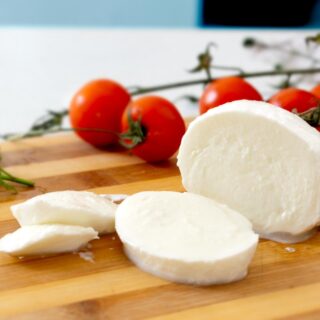
How to Make Homemade Mozzarella: A Step-by-Step Guide
Learn how to make delicious homemade mozzarella cheese from scratch. Follow our simple step-by-step guide and recipe video to shape fresh mozzarella balls and braids.
Ingredients
- 5 liters raw cow’s milk
- 5 teaspoons whole unsweetened yogurt
- liquid rennet see the quantities on the package
- Cold water
- Salt
- Ice
Instructions
- In a large steel pot, add the cold milk and heat over a moderate heat source for approximately 10 minutes. While heating, stir continuously with a wooden spoon to reach a uniform temperature of 40°C (105°F) throughout the milk. Use a cooking thermometer for accuracy.
- Remove the milk from the heat source, and add the yogurt and rennet, stirring gently to combine. This natural culture will help acidify the milk, creating the ideal environment for cheese formation. Cover the pot with a lid and allow it to rest undisturbed for one hour at room temperature. For optimal maturation of the milk, maintain a temperature of 37°C (98°F). To achieve this temperature, place the covered pot of hot milk inside an turned off oven and close the door. During this time, the milk will coagulate, forming a solid curd.
- After the first hour, the milk started to curdle, so with the long blade of a knife we make crisscross cuts to obtain squares. Then we cover the pot with the lid and place a cloth over the lid and let it rest for another 20 minutes to facilitate the separation from the whey.
- After allowing time, you can observe two distinct compounds in the pot: One resembles ricotta in appearance but with a firmer consistency, this is the curd. The other is a yellowish liquid known as whey. Now we break the rennet cubes into smaller pieces with a whisk. Then we cover the pot with a lid and cloth and let it rest for an additional 4 hours to further separate the whey and harden the curd.
- After resting, the curd settles at the bottom of the pan, so using a ladle we remove the whey. Then using a slotted spoon we put the curd in a colander and press well so the remaining whey can drain and allow the curd and its vapors to reach the proper acidity level. The ideal place for draining at a temperature of 37°C (98°F) is inside the turned off oven. After that, once draining finishes, we place the curd on a plate, cover it, and leave it to mature in the turned off oven. The maturation phase lasts about 18 hours.
- To test if the curd has reached the proper acidity level and texture, bring a small pot of water to a boil on the stove. Once boiling, remove the pot from the heat and add a piece of curd. Using a stick, check the curd by twisting it inside the pot. It should form a long thread or feel very elastic and malleable if the acidity is correct. The curd is ready when it starts to stretch during this test.
- We place the curd on a work table and cut it into strips. At the same time, we prepare two small pots of water. We will keep one pot on the stove to boil, maintaining a temperature of 90°C (194°F). The other pot we will keep at a temperature of 50°C (122°F).
- We also prepare another container with 2 liters of very cold water and dissolve 18 grams of salt, stirring with a spoon. This brine, also called preserving liquid, will allow the mozzarella to be preserved for several days. We also add ice cubes.
- In another container we insert the curd strips and first add a little water at 50°C (122°F) to soften it. Then we add two ladles of water at 90°C (194°F) and mix until the mixture begins to take shape.
- Now, the water of the mozzarella is about 70°C (158°F). So with a ladle we remove half the water from the bowl to add the boiling water. From here on it will begin to string. We continue to substitute the warm water with boiling water until a single mass is formed.
- We must delicately work the mozzarella and wrap it around itself as the dough strings. The cheese must be immersed often in hot water until the progressive hardening of the mass is perceived. This stretching process, known as “pasta filata,” gives mozzarella its characteristic texture. Once pliable, shape the cheese into balls or braids as desired.
- After shaping, immediately put mozzarellas in the container of cold salted water with ice to set its structure. Store the cheese with his salted water in refrigerator for 2-3 days.